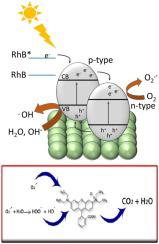Catalysis Today ( IF 5.2 ) Pub Date : 2020-12-28 , DOI: 10.1016/j.cattod.2020.12.014 Sonia Mancipe , José J. Martínez , Cristian Pinzón , Hugo Rojas , Dora Solis , Ricardo Gómez

|
In the current study, SnO2(5, 10 and 15 wt%)/MgAl-HT hydrotalcite-type materials were synthesized by co-precipitation method. Besides, the photocatalytic activity of the materials was evaluated in the degradation of Rhodamine B under simulated sunlight. The characterization of the materials by X-ray diffraction (XRD), Raman spectroscopy, physisorption of nitrogen and X-ray photoelectron spectroscopy (XPS) showed the formation of the (003) and (110) characteristic plans of lamellar materials, vibrational modes typical of layered double hydroxides and tin, specific surface areas, pore size distribution and chemical composition, respectively. The photocatalytic activity showed that the SnO2(10 %)/MgAl-HT catalyst has the best degradation of the dye reaching a 75 % of degradation after 210 min under simulated solar light irradiation. The route of action of charge carriers was evaluated using scavengers for photogenerated holes, hydroxyl and superoxide radicals, such as triethanolamine, isopropanol and benzoquinone, respectively, when benzoquinone was used it was confirmed that superoxide radicals play an important role in degradation of Rhodamine B.
中文翻译:

在阳光驱动下,使用锡半导体在水滑石型材料上有效光催化降解若丹明B
在本研究中,通过共沉淀法合成了SnO 2(5、10和15 wt%)/ MgAl-HT水滑石型材料。此外,在模拟日光下,评估了罗丹明B降解过程中材料的光催化活性。通过X射线衍射(XRD),拉曼光谱,氮的物理吸附和X射线光电子能谱(XPS)对材料进行表征,表明形成了层状材料的(003)和(110)特征计划,典型的振动模式层状双氢氧化物和锡的比表面积,比表面积,孔径分布和化学成分。光催化活性表明SnO 2(10%)/ MgAl-HT催化剂具有最佳的染料降解性能,在模拟太阳光照射下210分钟后达到75%的降解率。使用清除剂分别评估了光生空穴,羟基和超氧化物自由基(例如三乙醇胺,异丙醇和苯醌)的电荷载流子作用途径,当使用苯醌时,已证实超氧化物自由基在罗丹明B的降解中起重要作用。











































 京公网安备 11010802027423号
京公网安备 11010802027423号